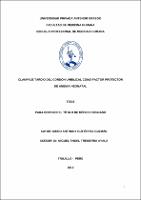| dc.contributor.advisor | Tresierra Ayala, Miguel Ángel | |
| dc.contributor.author | Gutiérrez Guzmán, Diego Anthony | |
| dc.creator | Gutiérrez Guzmán, Diego Anthony | |
| dc.date.accessioned | 2019-07-01T22:01:03Z | |
| dc.date.available | 2019-07-01T22:01:03Z | |
| dc.date.issued | 2019 | |
| dc.identifier.uri | https://hdl.handle.net/20.500.12759/5025 | |
| dc.description.abstract | Estudio observacional analítico tipo cohorte que tiene como objetivo analizar si el clampaje tardío del cordón umbilical es factor protector de anemia neonatal, pues se plantea favorablemente que dicho procedimiento mejora los niveles de hemoglobina en el futuro a corto y mediano plazo, sin embargo en nuestro medio no existen trabajos publicados al respecto. El estudio se realizó en hospitales de ESSALUD Trujillo entre Enero y Octubre del 2018, seleccionando de forma aleatoria 196 recién nacidos, los cuales fueron divididos en dos grupos de 98 neonatos según hayan presentado o no clampaje tardío del cordón umbilical al nacer. Se midió la hemoglobina en ambos grupos, la primera luego del nacimiento y posteriormente al mes de nacido. Los datos obtenidos indican que los neonatos que tuvieron clampaje tardío tienen una probabilidad de 9,11 de no tener anemia neonatal respecto a los que no tuvieron clampaje tardío X² = 109.3128; p = 0.0000; RR = 9.11; I. C. 95 % (4.86 – 17.08); por lo tanto se concluye que el clampaje tardío es factor protector de anemia neonatal. | es_PE |
| dc.description.abstract | Observational analytical cohort study that aims to analyze whether late clamping of the umbilical cord is protective factor of neonatal anemia, as it is favorably considered that this procedure improves hemoglobin levels in the short and medium term, however in our environment there are no published works in this regard. The study was conducted in ESSALUD Trujillo hospitals between January and October of 2018, randomly selecting 196 newborns, which were divided into two groups of 98 neonates according to whether or not they had late clamping of the umbilical cord at birth. Hemoglobin was measured in both groups, the first after birth and after the month of birth. The data obtained indicate that neonates who had late clamping have a probability of 9.11 of not having neonatal anemia with respect to those who did not have late clamping X2 = 109.3128; p = 0.0000; RR = 9.11; I. C. 95% (4.86 - 17.08); therefore, it is concluded that late clamping is a protective factor of neonatal anemia. | en_US |
| dc.description.uri | Tesis | es_PE |
| dc.format | application/pdf | es_PE |
| dc.language.iso | spa | es_PE |
| dc.publisher | Universidad Privada Antenor Orrego - UPAO | es_PE |
| dc.relation.ispartofseries | T_MED.HUMA_2577 | |
| dc.rights | info:eu-repo/semantics/openAccess | es_PE |
| dc.source | Universidad Privada Antenor Orrego | es_PE |
| dc.source | Repositorio Institucional - UPAO | es_PE |
| dc.subject | Clampaje tardío | es_PE |
| dc.subject | Cordón umbilical | es_PE |
| dc.subject | Anemia neonatal | es_PE |
| dc.subject | Hemoglobina | es_PE |
| dc.title | Clampaje tardío del cordón umbilical como factor protector de anemia neonatal | es_PE |
| dc.type | info:eu-repo/semantics/bachelorThesis | es_PE |
| thesis.degree.level | Título Profesional | es_PE |
| thesis.degree.grantor | Universidad Privada Antenor Orrego. Facultad de Medicina Humana | es_PE |
| thesis.degree.name | Médico Cirujano | es_PE |
| thesis.degree.discipline | Medicina Humana | es_PE |

